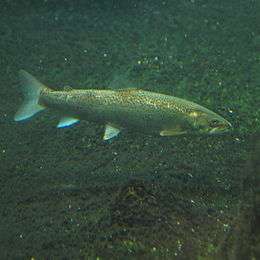Sakhalin taimen
| Japanese huchen Sakhalin taimen | |
|---|---|
 | |
 | |
| Scientific classification | |
| Kingdom: | Animalia |
| Phylum: | Chordata |
| Class: | Actinopterygii |
| Order: | Salmoniformes |
| Family: | Salmonidae |
| Genus: | Parahucho Vladykov, 1963 |
| Species: | P. perryi (Brevoort, 1856) |
| Synonyms | |
|
Hucho perryi | |
The Sakhalin taimen (Parahucho perryi, syn. Hucho perryi), also known as the Japanese huchen, is a large, East Asian species of fish in the salmon family (Salmonidae). It is found in the Primorsky Krai and Khabarovsk regions of eastern Russia, Sakhalin Island, the Kuril Islands and Hokkaido, Japan and inhabits lakes and large rivers. The population has been in general decline for a century at least. Contributory factors include degradation of the environment by logging, oil exploration and change of land use to agriculture. The fish is caught by commercial fishing as bycatch, by recreational anglers and illegally by poaching, and present populations are estimated to be less than 5% of their historic levels. The International Union for Conservation of Nature has rated the fish as being critically endangered.[1] Although initially placed in the genus Hucho, genetics and other evidence has shown that it belongs in its own monotypic genus Parahucho.[2][3][4]
Description
Parahucho perryi is one of largest, most ancient salmon species and primarily inhabits the lower to middle reaches of lakes and rivers. Fish over 30 cm (1 ft) long are almost exclusively piscivores, while the young feed mostly on aquatic insects. Females typically lay between 2,000 and 10,000 eggs in the spring on the sandy or gravelly river bottom.[5] The average specimens caught have weighed around 5 kg (11 lb).[1] The largest fish caught was recorded at 9.45 kg (20.8 lb) (IGFA world record). According to the unauthorized record of Japan, a fish with length of 2.1 m (6.9 ft) was captured in 1937 from the Tokachi River, Hokkaidō.
Distribution
Parahucho perryi are found in the Northwest Pacific: Sakhalin Island (Russia), the Island of Hokkaidō (Japan), and parts of the far eastern Russian mainland. Some populations spend all their lives in freshwater while others are anadromous. The fish take about eight years to mature and can spawn several times during their lifetime which estimated to be about fourteen years.[1]
Threats
The global population of the species has dwindled in recent years for a variety of reasons. The loss of more than 50% of their original habitat due to agriculture, urbanization, and more recently, oil and gas development, is a major factor. Other considerable pressures include bycatch in the commercial salmon fisheries of Russia and Japan, as well as illegal fishing practices in Russia. The fish are also prized as trophies by Japanese recreational anglers.[6]
In Japan, this species is bred for game-fishing at managed fishing sites, and raised fish are available for purchase. However, the species remains critically endangered.
Status
Since 2006, the IUCN has listed Parahucho perryi as critically endangered based on the assessment completed by the Salmonid Specialist Group. This designation represents the highest potential risk of global extinction to the species. The assessment revealed that the range-wide population has dropped in size to less than 5% of historic levels.[6]
References
- 1 2 3 4 Rand, P.S. (2006). "Hucho perryi". IUCN Red List of Threatened Species. Version 2007. International Union for Conservation of Nature. Retrieved 17 January 2016. Listed as Critically Endangered (CR A4abcd v3.1)
- ↑ Froese, Rainer and Pauly, Daniel, eds. (2016). "Parahucho perryi" in FishBase. August 2016 version.
- ↑ Oleinik, A.G.; and Skurikhina, L.A. (2008). Phylogenetic relationships of Sakhalin taimen Parahucho perryi inferred from PCR-RFLP analysis of mitochondrial DNA. Russian Journal of Genetics, 44:767. doi:10.1134/S102279540807003X
- ↑ Matveev, V.; Nishihara, H.; & Okada, N. (2007). Novel SINE families from salmons validate Parahucho (Salmonidae) as a distinct genus and give evidence that SINEs can incorporate LINE-related 3′-tails of other SINEs. Molecular Biology and Evolution 24(8): 1656-1666. doi: 10.1093/molbev/msm083
- ↑ Robins, C.R., R.M. Bailey, C.E. Bond, J.R. Brooker, E.A. Lachner, R.N. Lea and W.B. Scott, 1991. World fishes important to North Americans. Exclusive of species from the continental waters of the United States and Canada. Am. Fish. Soc. Spec. Publ. (21):243 p.(from fishbase, Hucho perryi)
- 1 2 Rand, Pete. "Ancient, Giant Salmon in Asia Edging Towards Extinction" Wild Salmon Center, May 23, 2006.
